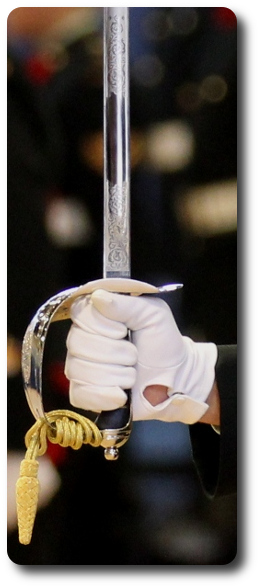Topic: Tradition

Military Weddings
Military Weddings Follow Traditions Which Provide Very Picturesque Settings
The bridegroom usually takes the responsibility of seeing that the groomsmen are equipped with proper trappings and borrows swords or sabers for those who do not have their own.
Ottawa Citizen, 29 May 1942
If the bridegroom is an army, a navy or an air force man, the bride-to-be should plan her wedding along military lines.
The chief difference between the military or naval wedding and and the ordinary civilian wedding is that the bridegroom is in uniform, and his ushers, chosen from among his military friends, are likewise in uniform. And another exciting difference is the formation of an arch of sabers or swords at the conclusion of the ceremony and again as the newlyweds leave the church.
The best man may or may not be a civilian, as it is considered only fitting that this member of the wedding party be the bridegroom's closest friend. All military personnel in the wedding party wear sidearms, and carry their caps. No boutonnieres are ever worn with the uniform.
The bridegroom leaves hi cap in the vestry. He enters from the front, the same as in any wedding, and the formation at the altar is usually similar to a civilian wedding.
 After the ceremony has been performed and the couple start to leave, the ushers draw their sabers—or swords for navy—at the command "Draw Sabers" (from one of the ushers) at the foot of the chancel steps and the bride and bridegroom pass beneath the arch. After they have passed through the ushers each take a bridesmaid down the aisle and out of the church. In marching out of the church, the bridegroom, best man and ushers offer their right arms to the bride, maid-of-honor and bridesmaids, thus avoiding entanglement of sabres or swords and dresses, and leaving the left hand free to carry the cap.
After the ceremony has been performed and the couple start to leave, the ushers draw their sabers—or swords for navy—at the command "Draw Sabers" (from one of the ushers) at the foot of the chancel steps and the bride and bridegroom pass beneath the arch. After they have passed through the ushers each take a bridesmaid down the aisle and out of the church. In marching out of the church, the bridegroom, best man and ushers offer their right arms to the bride, maid-of-honor and bridesmaids, thus avoiding entanglement of sabres or swords and dresses, and leaving the left hand free to carry the cap.
At the chapel steps the ushers reform the arch of swords for the bridal party to again pass under.
There is generally a toast to the bride at the reception, welcoming her into the army or navy, after which the best man and the ushers draw their sabers or swords together at the commands "Draw" and "Sabre" and cross them, forming an arch above the bride's head. The glasses are held high in the left hand and the toast is generally concluded with "How!"
Saber to Cut Cake
The bride cuts the cake with her husband's saber or sword. The husband may help her do this. She makes only the initial cut and should make a wish while doing so.
The bridal party enters the church as follows: Ushers, two by two; bridemaids, matron-of-honor, bride and father. There is no difference be tween a civilian and a military ceremony here, except that the ushers always walk together.
The bridegroom enters the church with the best man at the at the side entrance, or from the rector's study, taking an oblique position in front of the lectern. The bridal party marches down the aisle, and divides at the chancel steps, the ushers taking oblique positions half facing the congregation and the bridesmaids facing the same way only in front of and between each usher. The matron-of-honor takes her position opposite the best man. The bride and her father come down the aisle together and stand in the center facing the minister.
The bridegroom usually takes the responsibility of seeing that the groomsmen are equipped with proper trappings and borrows swords or sabers for those who do not have their own.
Air corps weddings follow the same pattern as laid-down for other military type weddings.

